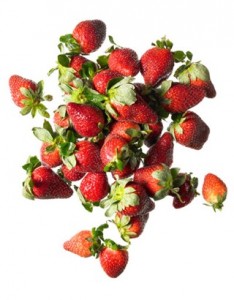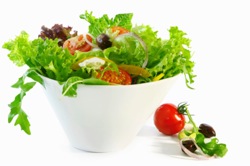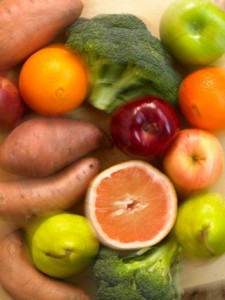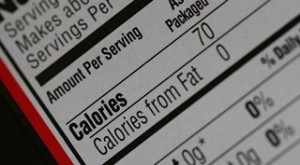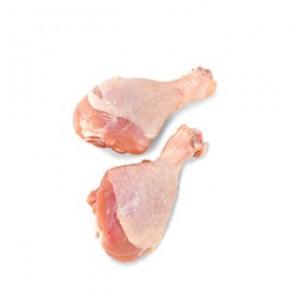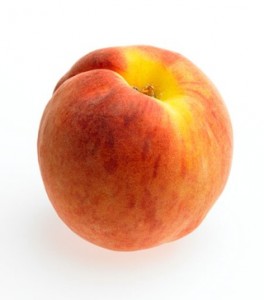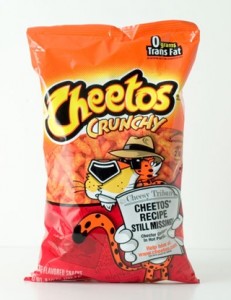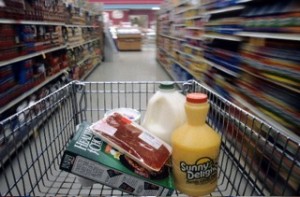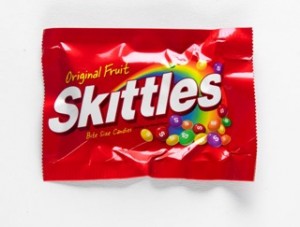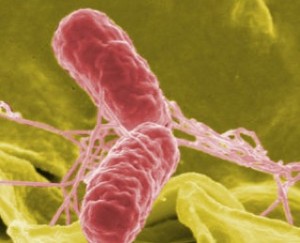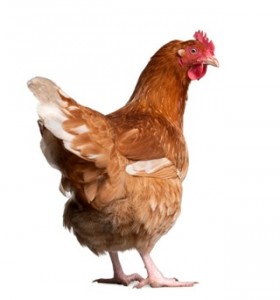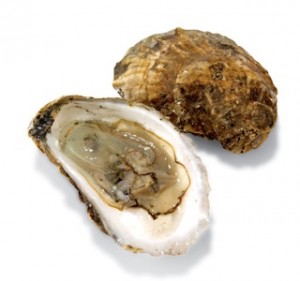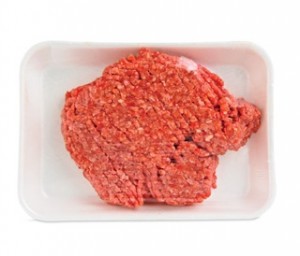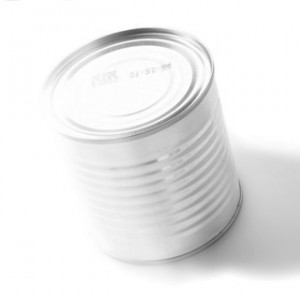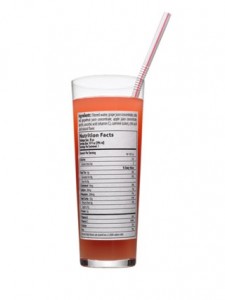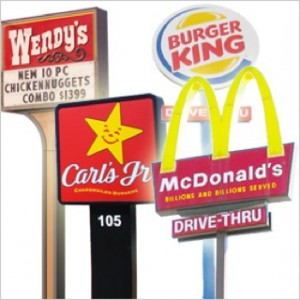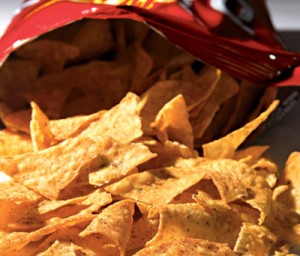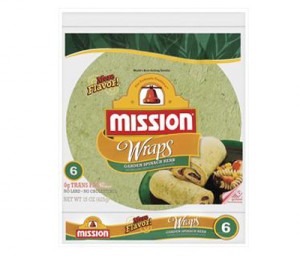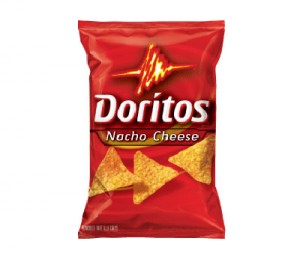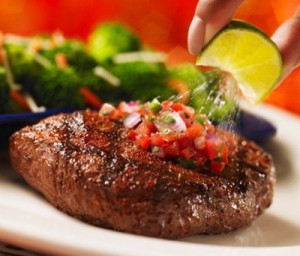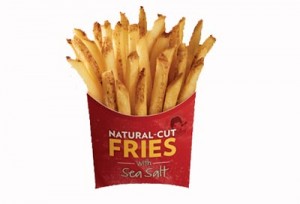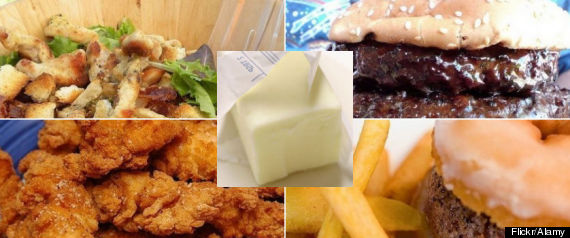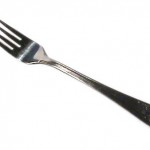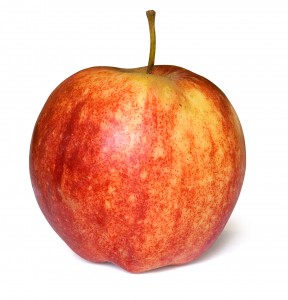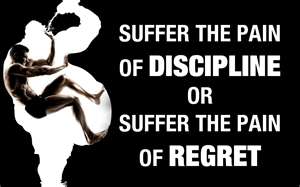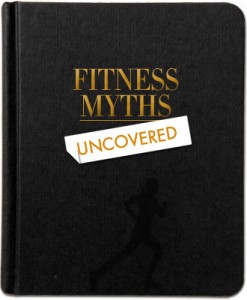Decades ago, around the time of Steven Tyler’s last haircut, a completely wrong-headed idea started being passed around America’s dinner tables: Eating fat makes you fat.
Wrong. Eating fat won’t make you fat, any more than eating money will make you rich. Calories make you fat, and most “low-fat” or “fat-free” foods actually have just as many calories as their full-fat versions, because of added sugar and chemicals. And there’s no debate on this one: Since we made “cut down on fat” our favorite food craze roughly 30 years ago, the U.S. obesity rate has doubled. Among children, it has tripled. That’s a failed food policy if ever there was one.
But it’s just one of many “get fat” habits that can be turned into a “slim-down” habit, starting today. All you need is a pinch of resolve and a few new routines. Here are the 20 habits you can replace right now . . .
#1: Eating “low-fat”
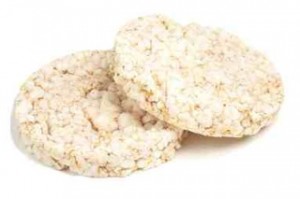 It sounds crazy, but stop buying foods marketed as low-fat or fat-free. Typically, they save you only a few calories and, in doing so, they replace harmless fats with low-performing carbohydrates that digest quickly—causing a sugar rush and, immediately afterward, rebound hunger. Researchers from the University of Alabama at Birmingham found that meals that limited carbohydrates to 43 percent were more filling and had a milder effect on blood sugar than meals with 55 percent carbohydrates. That means you’ll store less body fat and be less likely to eat more later.
It sounds crazy, but stop buying foods marketed as low-fat or fat-free. Typically, they save you only a few calories and, in doing so, they replace harmless fats with low-performing carbohydrates that digest quickly—causing a sugar rush and, immediately afterward, rebound hunger. Researchers from the University of Alabama at Birmingham found that meals that limited carbohydrates to 43 percent were more filling and had a milder effect on blood sugar than meals with 55 percent carbohydrates. That means you’ll store less body fat and be less likely to eat more later.
#2: Not seeking nutrition advice
Good news here: By reading this, you’re already forming habits that can help you shed pounds. When Canadian researchers sent diet and exercise advice to more than 1,000 people, they found that the recipients began eating smarter and working more physical activity into their daily routines. Not surprisingly, the habits of the non-recipients didn’t budge.
#3: Sleeping too little or too much
According to Wake Forest researchers, dieters who sleep five hours or less put on 2½ times more belly fat, while those who sleep more than eight hours pack on only slightly less than that. Shoot for an average of six to seven hours of sleep per night—the optimal amount for weight control.
#4: Eating free restaurant foods
Breadsticks, biscuits, and chips and salsa may be complimentary at some restaurants, but that doesn’t mean you won’t pay for them. Every time you eat one of Olive Garden’s free breadsticks or Red Lobster’s Cheddar Bay Biscuits, you’re adding an additional 150 calories to your meal. Eat three over the course of dinner and that’s 450 calories. That’s also roughly the number of calories you can expect for every basket of tortilla chips you get at your local Mexican restaurant. What’s worse, none of these calories comes paired with any redeeming nutritional value. Consider them junk food on steroids.
#5: Drinking soda—even diet!
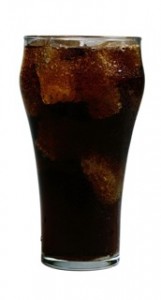 The average American guzzles nearly a full gallon of soda every week. Why is that so bad? Because a 2005 study found that drinking one to two sodas per day increases your chances of being overweight or obese by nearly 33 percent. And diet soda is no better. When researchers in San Antonio tracked a group of elderly subjects for nearly a decade, they found that compared to nondrinkers, those who drank two or more diet sodas a day watched their waistlines increase five times faster. The researchers theorize that the artificial sweeteners trigger appetite cues, causing you to unconsciously eat more at subsequent meals.
The average American guzzles nearly a full gallon of soda every week. Why is that so bad? Because a 2005 study found that drinking one to two sodas per day increases your chances of being overweight or obese by nearly 33 percent. And diet soda is no better. When researchers in San Antonio tracked a group of elderly subjects for nearly a decade, they found that compared to nondrinkers, those who drank two or more diet sodas a day watched their waistlines increase five times faster. The researchers theorize that the artificial sweeteners trigger appetite cues, causing you to unconsciously eat more at subsequent meals.
#6: Skipping meals
In a 2011 national survey from the Calorie Control Council, 17 percent of Americans admitted to skipping meals to lose weight. The problem is, skipping meals actually increases your odds of obesity, especially when it comes to breakfast. A study from the American Journal of Epidemiology found that people who cut out the morning meal were 4.5 times more likely to be obese. Why? Skipping meals slows your metabolism and boosts your hunger. That puts your body in prime fat-storage mode and increases your odds of overeating at the next meal.
#7: Eating too quickly
If your body has one major flaw, this is it: It takes 20 minutes for your stomach to tell your brain that it’s had enough. A study in the Journal of the American Dietetic Association found that slow eaters took in 66 fewer calories per meal, but compared to their fast-eating peers, they felt like they had eaten more. What’s 66 calories, you ask? If you can do that at every meal, you’ll lose more than 20 pounds a year!
#8: Watching too much TV
A University of Vermont study found that overweight participants who reduced their TV time by just 50 percent burned an additional 119 calories a day on average. That’s an automatic 12-pound annual loss! Maximize those results by multitasking while you watch—even light household tasks will further bump up your caloric burn. Plus, if your hands are occupied with dishes or laundry, you’ll be less likely to mindlessly snack—the other main occupational hazard associated with tube time.
#9: Ordering the combo meal
A study in the Journal of Public Policy & Marketing shows that compared to ordering a la carte, you pick up a hundred or more extra calories by opting for the “combo” or “value meal.” Why? Because when you order items bundled together, you’re likely to buy more food than you want. You’re better off ordering your food piecemeal. That way you won’t be influenced by pricing schemes designed to hustle a few more cents out of your pocket.
#10: Facing the buffet
Cornell researchers found that when eating at a buffet-style restaurant, obese diners were 15 percent more likely to choose seats with a clear view of the food. Your move: Choose a seat that places your back toward the spread. It will help you avoid fixating on the food.
#11: Eating off larger plates
 One study found that when given an option, a whopping 98.6 percent of obese individuals opt for larger plates. Translation: More food, more calories, and more body fat. Keep your portions in check by choosing smaller serving dishes. If need be, you can always go back for seconds.
One study found that when given an option, a whopping 98.6 percent of obese individuals opt for larger plates. Translation: More food, more calories, and more body fat. Keep your portions in check by choosing smaller serving dishes. If need be, you can always go back for seconds.
#12: Putting serving dishes on the table
Resist setting out foods buffet- or family-style, and opt instead to serve them from the kitchen. A study in the journal Obesity found that when food is served from the dinner table, people consume 35 percent more over the course of the meal. When an additional helping requires leaving the table, people hesitate to go back for more.
#13: Choosing white bread
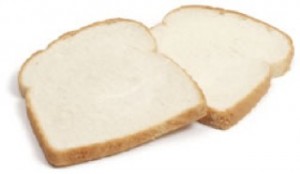 A study from the American Journal of Clinical Nutrition found that when obese subjects incorporated whole grains into their diets, they lost more abdominal fat over the course of 12 weeks. There are likely multiple factors at play, but the most notable is this: Whole grain foods pack in more fiber and an overall stronger nutritional package than their refined-grain counterparts.
A study from the American Journal of Clinical Nutrition found that when obese subjects incorporated whole grains into their diets, they lost more abdominal fat over the course of 12 weeks. There are likely multiple factors at play, but the most notable is this: Whole grain foods pack in more fiber and an overall stronger nutritional package than their refined-grain counterparts.
#14: Taking big bites
The American Journal of Clinical Nutrition found that people who took large bites of food consumed 52 percent more calories in one sitting than those who took small bites and chewed longer. By cutting food into smaller pieces, you can increase satiety and enjoy your food more thoroughly. A good general rule? The smaller your bites, the thinner your waistline.
#15: Not drinking enough water
 Adequate water intake is essential for all your body’s functions, and the more you drink, the better your chances of staying thin. In one University of Utah study, dieting participants who were instructed to drink two cups of water before each meal lost 30 percent more weight than their thirsty peers. And you can magnify the effect by adding ice. German researchers found that six cups of cold water a day could prompt a metabolic boost that incinerates 50 daily calories. That’s enough to shed five pounds a year!
Adequate water intake is essential for all your body’s functions, and the more you drink, the better your chances of staying thin. In one University of Utah study, dieting participants who were instructed to drink two cups of water before each meal lost 30 percent more weight than their thirsty peers. And you can magnify the effect by adding ice. German researchers found that six cups of cold water a day could prompt a metabolic boost that incinerates 50 daily calories. That’s enough to shed five pounds a year!
#16: Having overweight friends
Research from the New England Journal of Medicine indicates that when a friend becomes obese, it ups your chance of obesity by 57 percent. This probably has to do with the social norms that you’re exposed to. Rather than ditch a friend who starts to put on a few extra pounds though, suggest healthy activities that you can do together, and avoid letting him or her dictate the meal (“Let’s split the cheesecake!”).
#17: Eating too late
Your body can burn flab while you sleep, but only if it isn’t too busy processing a full stomach. A new study in the journal Obesity looked at the sleeping and eating habits of 52 people over seven days, and it found that those who ate after 8 p.m. took in the most daily calories and had the highest BMIs.
#18: Not using a scale
Looking at your body weight reinforces weight-loss goals and makes it difficult to cheat your diet. When University of Minnesota researchers observed dieters who weighed themselves daily, they discovered that the routine of stepping on a scale helped those people lose twice as much weight as those who weighed themselves less frequently. Avoid being thrown off by natural fluctuations in body weight by stepping onto the scale at the same time every day.
#19: Drinking fruity beverages
Most restaurants and bars have ditched their fresh-fruit recipes in favor of viscous syrups made mostly from high fructose corn syrup and thickening agents. As a general rule, the more garnishes a drink has hanging from its rim, the worse it is for your waistline.
#20: Eating when emotional
A study from the University of Alabama found that emotional eaters—those who admitted eating in response to emotional stress—were 13 times more likely to be overweight or obese. If you feel the urge to eat in response to stress, try chewing a piece of gum, chugging a glass of water, or taking a walk around the block. Create an automatic response that doesn’t involve food and you’ll prevent yourself from overloading on calories.
